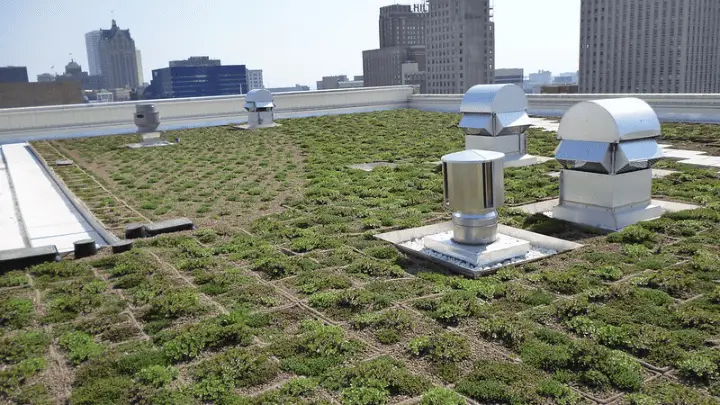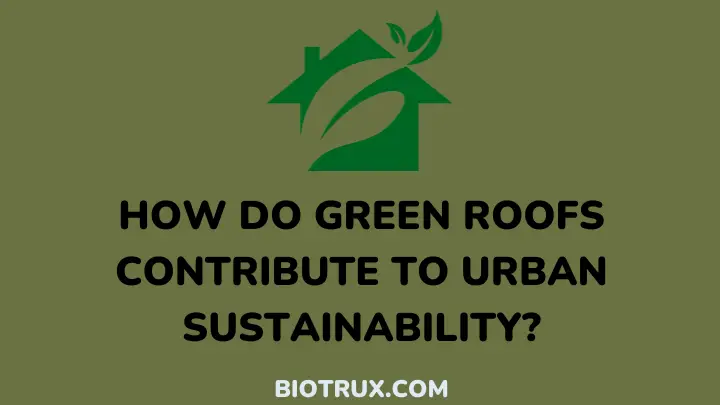What are green roofs, and how do they contribute to urban sustainability? Green roofs are roofs that are partially or completely covered with vegetation, such as grasses, flowers, herbs, or even trees.
They provide many benefits for the environment and the people living in urban areas, such as reducing the heat island effect, improving air quality, enhancing biodiversity, saving energy, and mitigating stormwater runoff.
In this article, you will explore how green roofs contribute to urban sustainability, which is the ability of cities to meet the needs of their current and future generations without compromising the natural resources and ecosystems that support them.
Urban sustainability is becoming more and more crucial as the world’s population and urbanization rates increase, putting pressure on the environment and human well-being.
By reading this article, you will learn how green roofs can help create more livable, resilient, and healthy cities for everyone.
1. Improved Stormwater Management
One of the ways that green roofs contribute to urban sustainability is by improving stormwater management. Stormwater management refers to the planning, control, and treatment of rainfall runoff.
When rain falls on urban surfaces like roads, rooftops, and pavements, it may not be absorbed naturally into the ground. Instead, it becomes stormwater runoff, which can pick up pollutants and cause flooding.
Green roofs can reduce the amount of stormwater runoff by absorbing and retaining rainwater in their vegetation and substrate layers. This can mitigate urban flooding and reduce the pressure on stormwater infrastructure.
Moreover, green roofs can filter pollutants from rainwater, such as nitrogen, phosphorus, metals and bacteria, improving the quality of water that reaches the streams and rivers. By enhancing stormwater management, green roofs can provide multiple benefits for the urban environment and its inhabitants.
2. Enhanced Biodiversity
Another way that green roofs contribute to urban sustainability is by enhancing biodiversity. Green roofs create habitats for birds, insects, and plants that otherwise would have limited space in urban areas.
By providing food, shelter, and nesting opportunities, green roofs promote urban biodiversity and help conserve native species. Green roofs also play a role in supporting local ecosystems by facilitating pollination, pest control, and seed dispersal.
These ecological services benefit not only the green roof owners but also the surrounding community and environment. Therefore, green roofs are a valuable tool for urban sustainability that can increase biodiversity and ecosystem health.
3. Improved Air Quality
Green roofs are unique and innovative roofing systems that incorporate vegetation into the building structure. These roofs are designed to support plant life that performs photosynthesis, a natural process that transforms carbon dioxide into breathable oxygen, thereby reducing greenhouse gas emissions.
In addition to this, green roofs also act as natural air filters, removing harmful pollutants and particulate matter from the air such as dust, smoke, and smog. By doing so, they help to improve the air quality, reducing the risk of respiratory problems and improving the overall health of urban residents.
4. Temperature Regulation
One of the ways that green roofs contribute to urban sustainability is by regulating temperature. Green roofs can reduce the urban heat island effect, which is the phenomenon of higher temperatures in urban areas compared to rural ones.
By covering the rooftops with vegetation, green roofs can lower the surface and air temperatures of buildings and surrounding areas. This cooling effect can also improve energy efficiency and reduce air conditioning usage, which can lower greenhouse gas emissions and save money.
Green roofs are, therefore, a smart and eco-friendly solution for urban temperature regulation.
5. Energy Conservation
Green roofs are a valuable addition to urban environments as they offer numerous benefits to the environment and inhabitants. One of the primary advantages of green roofs is their ability to enhance the energy conservation of buildings.
With their insulating properties, green roofs help to reduce the amount of heat that is lost or gained through the roof, which in turn reduces the energy consumption required for heating and cooling.
This results in increased building energy efficiency, which is a crucial factor in determining the sustainability and environmental performance of a building. Additionally, by reducing energy consumption, green roofs play a vital role in reducing greenhouse gas emissions and mitigating the impacts of climate change.
6. Aesthetic Appeal
Another way that green roofs contribute to urban sustainability is by enhancing the aesthetic appeal of the cityscape. Green roofs can create a natural contrast to the concrete and steel structures that dominate most urban environments.
They provide visual relief for the residents and visitors. Green roofs can also increase the biodiversity and ecological value of the city by attracting birds, insects, and other wildlife.
Green roofs can improve the quality of life and well-being of the urban population by offering opportunities for recreation, relaxation, and education. These roofs can also foster a sense of community and social cohesion by creating shared spaces and encouraging social interactions.
7. Community Well-Being
One of the ways that green roofs contribute to urban sustainability is by enhancing community well-being. Green roofs provide recreational opportunities for residents and visitors, such as gardening, socializing, or enjoying nature.
They also offer mental health benefits, such as reducing stress, improving mood, and increasing cognitive function. By creating more green spaces in the city, green roofs can foster a sense of belonging, connection, and happiness among urban dwellers.
Green roofs are not only good for the environment, but also for the people who live and work in it.
8. Increased Property Value
Green roofs can attract businesses and residents who are looking for eco-friendly and aesthetically pleasing spaces. They can also provide economic benefits for property owners, such as lower energy costs, reduced stormwater fees, and extended roof lifespan.
Moreover, green roofs can have a positive impact on real estate markets, as they can increase the demand and price of properties with green features.
By investing in green roofs, property owners can not only enhance the environmental performance of their buildings but also improve their financial returns.
9. Long-Term Durability and Roof Protection
One of the ways that green roofs contribute to urban sustainability is by enhancing the long-term durability and protection of the roof. Green roofs can shield the roof from harmful UV radiation and extreme weather conditions, such as hail, wind, and temperature fluctuations.
This reduces the risk of cracks, leaks, and deterioration of the roof membrane. As a result, green roofs can extend the lifespan of the roof by up to three times, compared to conventional roofs.
This also means that green roofs can lower the costs of roof maintenance and replacement, making them more cost-effective in the long run. Therefore, green roofs are not only beneficial for the environment but also for the building owners and occupants.
10. Noise Reduction
Noise pollution is a serious problem in many cities, affecting the health and well-being of residents and workers. Green roofs can help to absorb sound waves and reduce the reflection of noise from hard surfaces.
By creating a layer of vegetation on top of buildings, green roofs can contribute to a quieter urban environment and improve the overall acoustic quality.
Green roofs can also reduce the need for artificial cooling and heating, which can lower the energy consumption and greenhouse gas emissions of buildings. Therefore, green roofs are not only aesthetically pleasing but also environmentally beneficial.

FAQs
Do green roofs require special irrigation systems?
Green roofs do benefit from specialized irrigation systems to ensure optimal plant health. Automated systems with sensors are often used for efficient water management.
Can any building support a green roof?
In theory, many buildings can support green roofs, but structural considerations are crucial. Consultation with a structural engineer is essential to determine feasibility.
Are green roofs expensive to install?
While the initial installation cost may be higher, the long-term economic and environmental benefits often outweigh the upfront expenses.
Can green roofs prevent floods in urban areas?
Yes, green roofs play a vital role in stormwater management, reducing runoff and preventing floods in urban areas.
Are there regulations for installing green roofs in urban areas?
Regulations vary by location. Some cities offer incentives, while others may have specific guidelines for green roof installations.
Wrapping Up
Green roofs are more than just a way to beautify the urban landscape. They are also a powerful tool for enhancing the sustainability of cities by reducing energy consumption, improving air quality, mitigating urban heat island effects, and providing habitat for biodiversity.
Green roofs can also improve the well-being of urban residents by creating green spaces for recreation, relaxation, and social interaction. By installing green roofs, we can transform our cities into more livable, resilient, and eco-friendly places.
In this article, you have discovered some of the ways that green roofs contribute to urban sustainability. I hope this blog has inspired you to learn more about green roofs and consider how they can contribute to your own urban sustainability goals.
You can also learn more about how smart cities are sustainable.
Thanks for reading.

